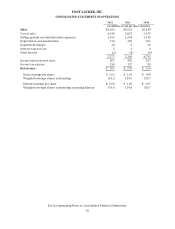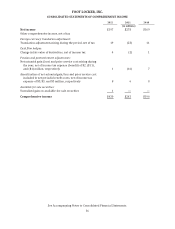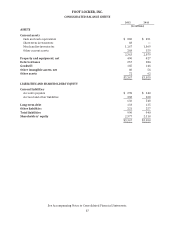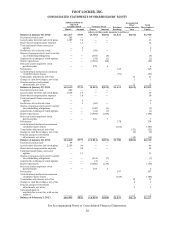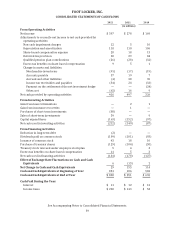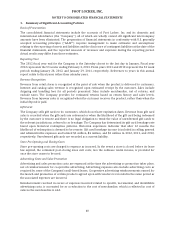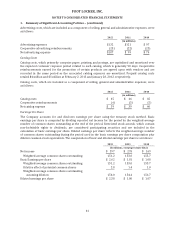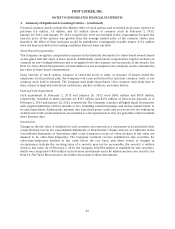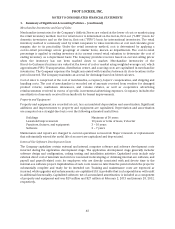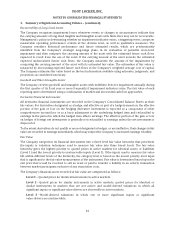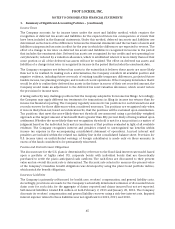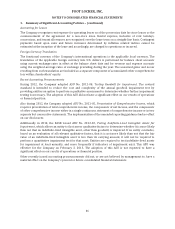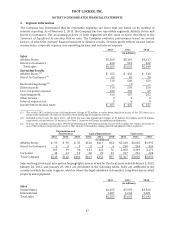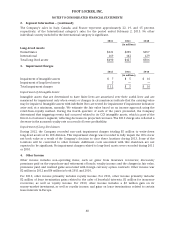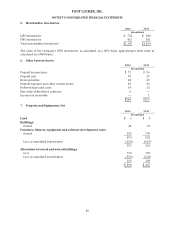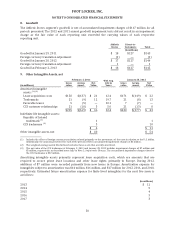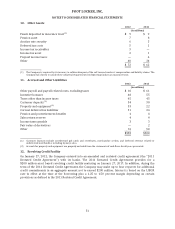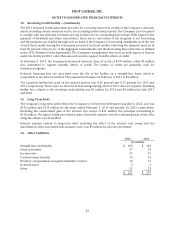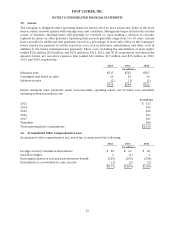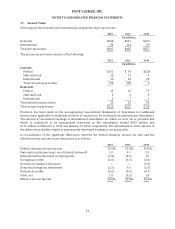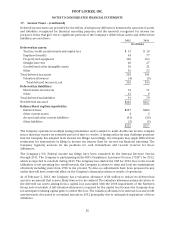Foot Locker 2012 Annual Report Download - page 65
Download and view the complete annual report
Please find page 65 of the 2012 Foot Locker annual report below. You can navigate through the pages in the report by either clicking on the pages listed below, or by using the keyword search tool below to find specific information within the annual report.FOOT LOCKER, INC.
NOTES TO CONSOLIDATED FINANCIAL STATEMENTS
1. Summary of Significant Accounting Policies − (continued)
Income Taxes
The Company accounts for its income taxes under the asset and liability method, which requires the
recognition of deferred tax assets and liabilities for the expected future tax consequences of events that
have been included in the financial statements. Under this method, deferred tax assets and liabilities are
determined on the basis of the differences between the financial statements and the tax basis of assets and
liabilities using enacted tax rates in effect for the year in which the differences are expected to reverse. The
effect of a change in tax rates on deferred tax assets and liabilities is recognized in income in the period
that includes the enactment date. Deferred tax assets are recognized for tax credits and net operating loss
carryforwards, reduced by a valuation allowance, which is established when it is more likely than not that
some portion or all of the deferred tax assets will not be realized. The effect on deferred tax assets and
liabilities of a change in tax rates is recognized in income in the period that includes the enactment date.
The Company recognizes net deferred tax assets to the extent that it believes these assets are more likely
than not to be realized. In making such a determination, the Company considers all available positive and
negative evidence, including future reversals of existing taxable temporary differences, projected future
taxable income, tax-planning strategies, and results of recent operations. If the Company determines that it
would be able to realize their deferred tax assets in the future in excess of their net recorded amount, the
Company would make an adjustment to the deferred tax asset valuation allowance, which would reduce
the provision for income taxes.
A taxing authority may challenge positions that the Company adopted in its income tax filings. Accordingly,
the Company may apply different tax treatments for transactions in filing its income tax returns than for
income tax financial reporting. The Company regularly assesses its tax positions for such transactions and
records reserves for those differences when considered necessary. Tax positions are recognized only when
it is more likely than not, based on technical merits, that the positions will be sustained upon examination.
Tax positions that meet the more-likely-than-not threshold are measured using a probability weighted
approach as the largest amount of tax benefit that is greater than fifty percent likely of being realized upon
settlement. Whether the more-likely-than-not recognition threshold is met for a tax position is a matter of
judgment based on the individual facts and circumstances of that position evaluated in light of all available
evidence. The Company recognizes interest and penalties related to unrecognized tax benefits within
income tax expense in the accompanying consolidated statement of operations. Accrued interest and
penalties are included within the related tax liability line in the consolidated balance sheet. Provision for
U.S. income taxes on undistributed earnings of foreign subsidiaries is made only on those amounts in
excess of the funds considered to be permanently reinvested.
Pension and Postretirement Obligations
The discount rate for the U.S. plans is determined by reference to the Bond:Link interest rate model based
upon a portfolio of highly rated U.S. corporate bonds with individual bonds that are theoretically
purchased to settle the plan’s anticipated cash outflows. The cash flows are discounted to their present
value and an overall discount rate is determined. The discount rate selected to measure the present value
of the Company’s Canadian benefit obligations was developed by using the plan’s bond portfolio indices,
which match the benefit obligations.
Insurance Liabilities
The Company is primarily self-insured for health care, workers’ compensation, and general liability costs.
Accordingly, provisions are made for the Company’s actuarially determined estimates of discounted future
claim costs for such risks, for the aggregate of claims reported and claims incurred but not yet reported.
Self-insured liabilities totaled $14 million at both February 2, 2013 and January 28, 2012. The Company
discounts its workers’ compensation and general liability reserves using a risk-free interest rate. Imputed
interest expense related to these liabilities was not significant for 2012, 2011, and 2010.
45


